

Chinese cabbage. Chinese cabbage (Brassica rapa, subspecies pekinensis and chinensis) can refer to two distinct varieties of Chinese leaf vegetables often used in Chinese cuisine: Pekinensis (napa cabbage) and Chinensis (bok choi).
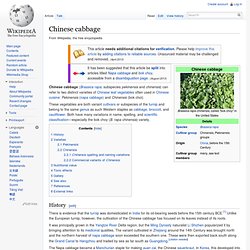
History[edit] There is evidence that the turnip was domesticated in India for its oil-bearing seeds before the 15th century BCE.[1] Unlike the European turnip, however, the cultivation of the Chinese cabbage has focused on its leaves instead of its roots. It was principally grown in the Yangtze River Delta region, but the Ming Dynasty naturalist Li Shizhen popularized it by bringing attention to its medicinal qualities. The variant cultivated in Zhejiang around the 14th Century was brought north and the northern harvest of napa cabbage soon exceeded the southern one. These were then exported back south along the Grand Canal to Hangzhou and traded by sea as far south as Guangdong. How To Grow Cilantro Indoors. By Molly Lavins Growing cilantro indoors can be as successful and flavorful as growing cilantro in your garden if you give the plant a little extra care.

When planting cilantro indoors, it’s best not to transplant plants from your garden. Cilantro does not transplant well. When you grow cilantro indoors, start with seeds or starter plants. Ultimately, make sure that your plants are 3 to 4 inches apart. Tips for Growing Cilantro Indoors Advertisement It’s best to use an unglazed terra cotta container when growing cilantro inside because it allows for greater moisture and air to pass through the roots. Lovage. How to Grow Mustard. January 23rd, 2009 Email 148 users recommend Phillip Harvey Louisa Rawle Tiné A field of mustard.
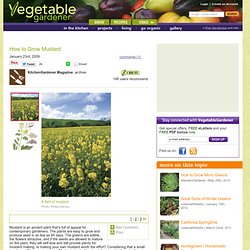
Photo: Phillip Harvey Mustard is an ancient plant that’s full of appeal for contemporary gardeners. Mustard likes light frost. Garden cress. This annual plant can reach a height of 60 cm (~24 inches), with many branches on the upper part.
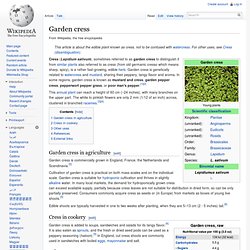
The white to pinkish flowers are only 2 mm (1/12 of an inch) across, clustered in branched racemes.[3][4] Garden cress in agriculture[edit] Claytonia perfoliata. Claytonia perfoliata (Indian lettuce, spring beauty, winter purslane, or miner's lettuce ; syn.
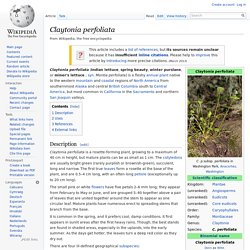
Montia perfoliata) is a fleshy annual plant native to the western mountain and coastal regions of North America from southernmost Alaska and central British Columbia south to Central America, but most common in California in the Sacramento and northern San Joaquin valleys. Description[edit] The small pink or white flowers have five petals 2–6 mm long; they appear from February to May or June, and are grouped 5–40 together above a pair of leaves that are united together around the stem to appear as one circular leaf.
Mature plants have numerous erect to spreading stems that branch from the base. Archives. Endive, Chicory and Witloof Description - Endive (Cichorium endiva) and chicory Cichorium intybus) are members of the Composite family.
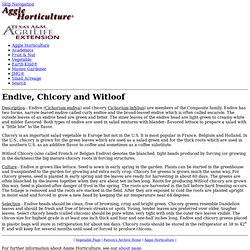
Endive has two forms, narrow-leaved endive called curly endive and the broad-leaved endive which is often called escarole. The outside leaves of an endive head are green and bitter. The inner leaves of the endive head are light green to creamy-white and milder flavored. Both types of endive are used in salad mixtures with blander- flavored lettuce to prepare a salad with a "little bite" to the flavor. Chicory is an important salad vegetable in Europe but not in the U.S. Barbarea verna. Land cress (Barbarea verna), also known as American cress, bank cress, black wood cress, Belle Isle cress, Bermuda cress, early yellowrocket, early wintercress, scurvy cress, creasy greens, and upland cress, is a biennial herb in the family Brassicaceae.
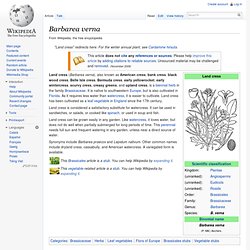
It is native to southwestern Europe, but is also cultivated in Florida. As it requires less water than watercress, it is easier to cultivate. Land cress has been cultivated as a leaf vegetable in England since the 17th century. How to grow watercress at home. Home grow watercress at home Growing watercress at home is actually Very easy despite the myth that watercress needs flowing water in order to grow.
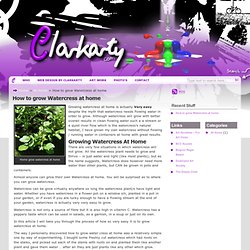
Although watercress will grow with better overall results in clean flowing water such a a stream or a quiet river flow which is the watercress’s natural habitat, I have grown my own watercress without flowing / running water in containers at home with great results. Watercress. The hollow stems of watercress are floating, and the leaves are pinnately compound.
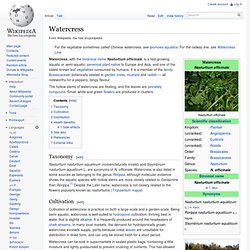
Small, white and green flowers are produced in clusters. Taxonomy[edit] Nasturtium nasturtium-aquaticum (nomenclaturally invalid) and Sisymbrium nasturtium-aquaticum L. are synonyms of N. officinale. Eruca sativa. Eruca sativa (syn.
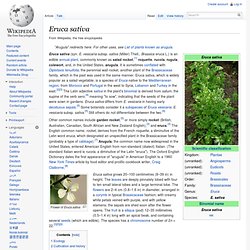
E. vesicaria subsp. sativa (Miller) Thell., Brassica eruca L.) is an edible annual plant, commonly known as salad rocket,[1] roquette, rucola, rugula, colewort, and, in the United States, arugula. It is sometimes conflated with Diplotaxis tenuifolia, the perennial wall rocket, another plant of the Brassicaceae family, which in the past was used in the same manner. Eruca sativa, which is widely popular as a salad vegetable, is a species of Eruca native to the Mediterranean region, from Morocco and Portugal in the west to Syria, Lebanon and Turkey in the east.[2][3] The Latin adjective sativa in the plant's binomial is derived from satum, the supine of the verb sero,[4] meaning "to sow", indicating that the seeds of the plant were sown in gardens. Eruca sativa differs from E. vesicaria in having early deciduous sepals.[5] Some botanists consider it a subspecies of Eruca vesicaria: E. vesicaria subsp. sativa.[5] Still others do not differentiate between the two.[6]
Crambe maritima. Crambe maritima flowers; Saaremaa, Estonia Blanched Crambe Maritima As an ornamental garden plant, C. maritima has gained the Royal Horticultural Society's Award of Garden Merit.[4] References[edit] External links[edit]